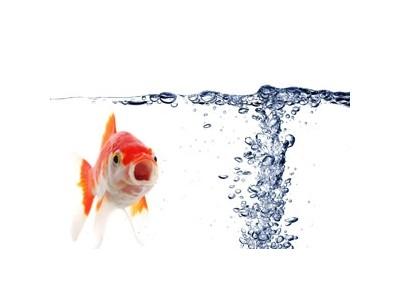Dissolved Oxygen

What is dissolved oxygen?
Oxygen gas dissolves freely in fresh water. Thus, oxygen from the atmosphere as well as that produced as a by-product of photosynthesis may increase the dissolved oxygen concentration in water. Oxygen is removed from the water through the processes of respiration (by both plants and animals) as well as other chemical reactions, including the decomposition of organic wastes entering the water.
The distribution of dissolved oxygen (DO) within an aquatic environment may vary horizontally or vertically and with time. Its distribution is dependent upon atmospheric contact, biological activity, wave and current actions, thermal phenomena, waste inputs and other characteristics of a lake or stream. High levels of oxygen are likely in surface water on windy days. Dissolved oxygen levels are also temperature and pressure dependent. Cold water holds more oxygen than warm water.
Photosynthesis contributes to an increase in dissolved oxygen levels during the day. However, there are biological processes in water that consume oxygen such as respiration by organisms and decomposition of organic matter by microorganisms. The oxygen consumed by these processes is called the Biological Oxygen Demand or BOD. When demand for oxygen is high and oxygen production from photosynthesis is not occurring such as before sunrise, dissolved oxygen readings can be low. Dissolved oxygen in the littoral zone may show a 4-6 mg/L diurnal fluctuation.
Deep areas of a lake would be expected to yield low dissolved oxygen readings. In summer, there are times when the dissolved oxygen at the bottom of Spring Lake approaches zero. During spring and fall turnovers, horizontal and vertical variation of dissolved oxygen is likely to be less than during the summer.
How is dissolved oxygen measured?
Since an adequate supply of oxygen is necessary to support life in a body of water, a determination of the amount of oxygen provides a means of assessing the quality of the water with respect to sustaining life. A standard chemical method to determine the amount of oxygen dissolved in a water sample is a type of titration, the Azide Modification of the Winkler Method. Precisely measured amounts of chemicals (reagents) are added to a water sample until a color change is achieved. A color change (or electrical measurement for other types of titration) marks the endpoint of the test. Two dissolved oxygen methods are used for student trips on the vessels: the Hach method with a digital titrator or a LaMotte kit. Another way to measure dissolved oxygen is to use a dissolved oxygen (DO) meter and probe. Units for measuring dissolved oxygen are parts per million (ppm) or milligrams per liter (mgL).
Because the solubility of oxygen in water is dependent upon temperature, pressure, and ionic concentrations, it is also important to calculate percentage saturation. A nomogram will permit a quick approximate oxygen saturation values ( Figure 11). The saturation point indicates the level at which water will not generally hold any more oxygen at a given temperature. Supersaturation occurs when the water holds more oxygen molecules than usual for a given temperature. Sunny days with lots of photosynthesis or turbulent water conditions can lead to supersaturation. A water sample is "saturated" at 100% and "supersaturated" above 100%.
What is the significance of dissolved oxygen?
Dissolved oxygen levels provide information about the biological, biochemical, and inorganic chemical reactions occurring in aquatic environments. Most aquatic organisms are highly dependent upon dissolved oxygen and will experience stress, or perhaps even be eliminated from a system, when dissolved oxygen levels fall below about 3.0 ppm (parts per million). Trout species normally require an oxygen concentration greater than 10 ppm (10 mgL) whereas carp can live in water containing as little as 1-2 ppm (1-2 mgL) oxygen.
Poor water quality is also indicated by low percent saturation readings. Levels below 60% may happen with rapid biological processes such as decomposition or high temperatures. Supersaturation can be a problem for organisms in that blood oxygen levels can increase resulting in gas bubbles in the blood.
Guidelines for Interpretation of Dissolved Oxygen Readings
For mg/L:
• 0-2 mg/L: not enough oxygen to support life
• 2-4 mg/L: only a few kinds of fish and insects can survive
• 4-7 mg/L: acceptable for warm water fish
• 7-11 mg/L: very good for most stream fish including cold water fish
For percent saturation:
• Below 60%: poor; water too warm or bacteria using up DO
• 60-79%: acceptable for most aquatic organisms
• 80-125%: excellent for most aquatic organisms
• 112% or more: too high, may be dangerous to fish
Adapted from Testing the Waters, S. Behar, River Water Network, 1996
Có thể bạn quan tâm
Phần mềm

Phối trộn thức ăn chăn nuôi

Pha dung dịch thủy canh

Định mức cho tôm ăn

Phối trộn phân bón NPK

Xác định tỷ lệ tôm sống

Chuyển đổi đơn vị phân bón

Xác định công suất sục khí

Chuyển đổi đơn vị tôm

Tính diện tích nhà kính

Tính thể tích ao hồ



 Hanoi announces causes of mass fish deaths after…
Hanoi announces causes of mass fish deaths after…